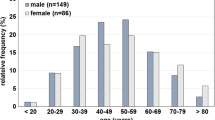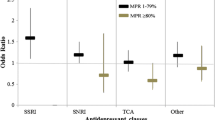Abstract
All forensic autopsy cases in southern Sweden in 1986–89 in which antidepressant drugs were found in the blood were assessed and the findings related to the sales of antidepressants as expressed as defined daily doses per 1,000 inhabitants per day. There was a total of 272 antidepressant-positive cases, which were divided in three groups: 1. suicide or possible suicide caused by antidepressant drugs, 2. suicide or possible suicide caused by other means (including other drugs and other toxic agents), and 3. other deaths.
Amitriptyline was the agent most commonly involved in suicide or possible suicide caused by antidepressants, and it was also the most commonly sold antidepressant. When corrected for sales, trimipramine was most frequently involved as the causal agent.
Conversely, despite frequent sales, lofepramine appeared only rarely to be involved. This may be related to lower toxicity of lofepramine, reduced lofepramine absorption at overdose and/or to differences in the administration of various antidepressant drugs to patients with differing degrees of risk of suicide.
Similar content being viewed by others
References
Stern H, Konetschny J, Herrmann L, Säwe U, Belz GG (1985) Cardiovascular effects of single doses of the antidepressants amitriptyline and lofepramine in healthy subjects. Pharmacopsychiatry 78: 272–277
Leonhard BE (1987) A comparison of the pharmacological properties of the novel tricyclic antidepressant lofepramine with its major metabolite, desipramine: a review. Int Clin Psychopharmacol 2: 281–297
Reid F, Henry JA (1990) Lofepramine overdosage. Pharmacopsychiatry 23: 23–27
Wessling A, Boëthius G (1990) Measurements of drug use in a defined population. Evaluation of the defined daily dose (DDD) methodology. Eur J Clin Pharmacol 39: 207–210
Wessling A, Bergman U, Westerholm N (1991) On the differences in psychotropic drug use between the three major urban areas in Sweden. Eur J Clin Pharmacol 40: 495–500
Barraclough BM (1974) Are there safer hypnotics than barbiturates? Lancet I: 57–58
King LA, Moffat AC (1983) A possible index of fatal drug toxicity in humans. Med Sci Law 23: 193
Henry JA (1989) A fatal toxicity index for antidepressant poisoning. Acta Psychiatr Scand 80 [Suppl 354]: 37–45
Cassidy S, Henry J (1987) Fatal toxicity of antidepressant drugs in overdose. Br Med J 295: 1021–1024
Beaumont G (1989) Suicide and antidepressant overdosage in general practice. Br J Psychiatry 155 [Suppl 6]: 27–31
Erikson E, Rohte O (1970) Chemistry and pharmacology of a new potential antidepressant. Arzneimittelforschung (Drug Research) 20: 1561–1569
Author information
Authors and Affiliations
Rights and permissions
About this article
Cite this article
Malmvik, J., Löwenhielm, C.G.P. & Melander, A. Antidepressants in suicide: differences in fatality and drug utilisation. Eur J Clin Pharmacol 46, 291–294 (1994). https://doi.org/10.1007/BF00194393
Received:
Accepted:
Issue Date:
DOI: https://doi.org/10.1007/BF00194393




